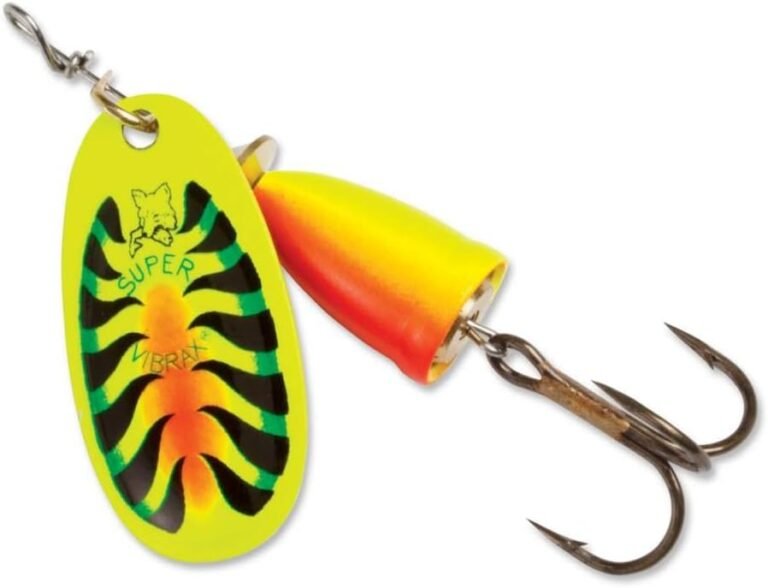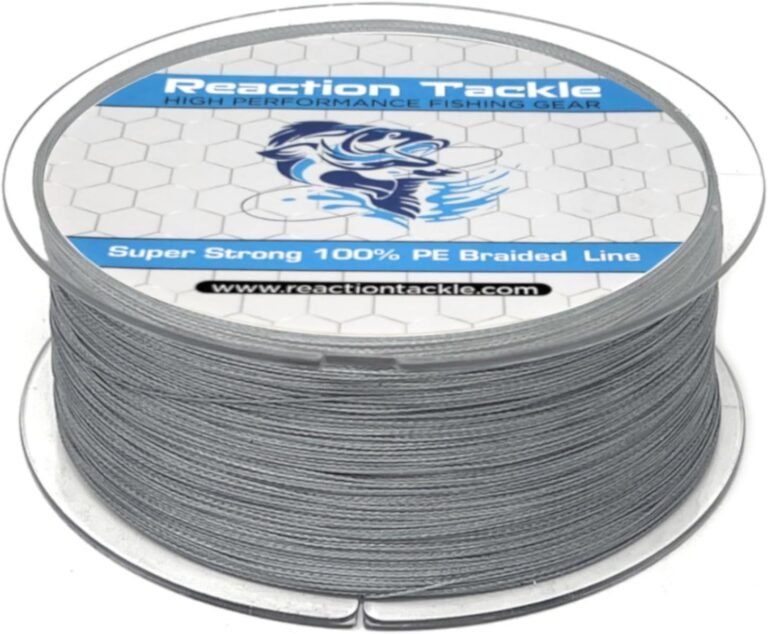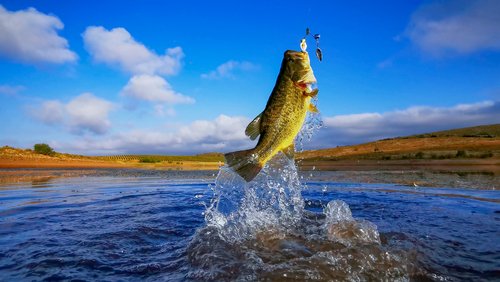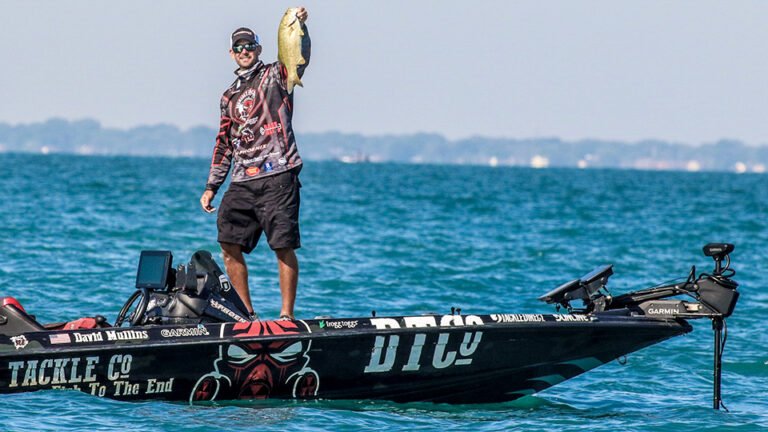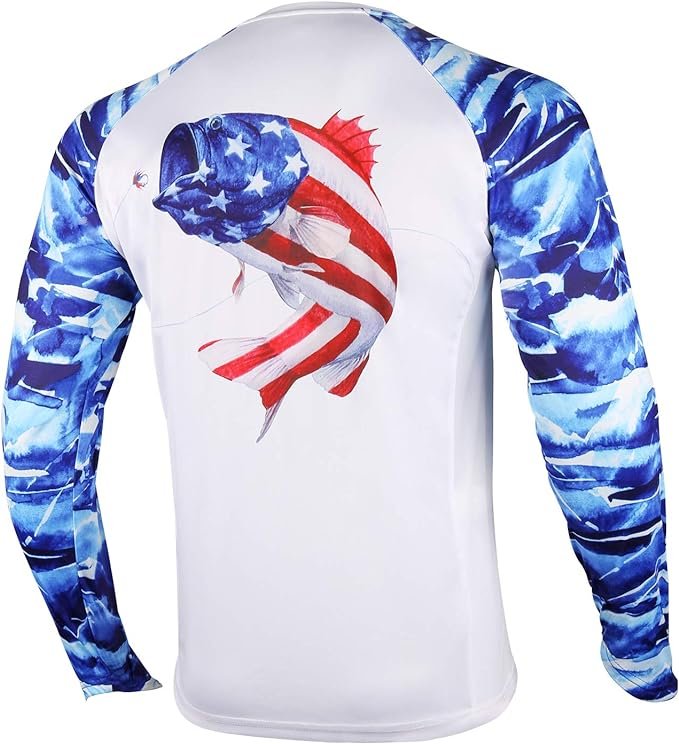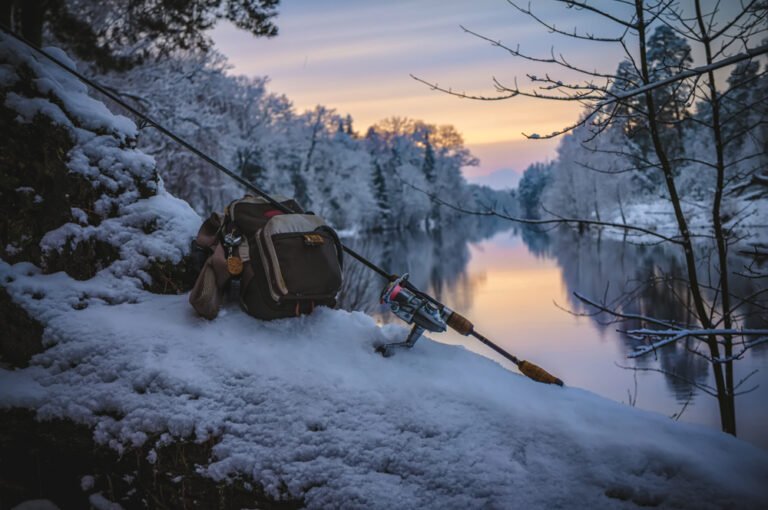As winter’s icy grip finally relinquishes its hold, spring breathes new life into the natural world. As fish emerge from their winter hideaways, driven by impulses to feed and spawn, it’s time for fishing in spring.

The warming waters provide an ideal environment for fish activity to intensify. Within the realm of spring fishing, bass reign supreme as one of the most sought-after species.
Whether targeting largemouth or smallmouth bass, anglers are drawn to the challenge that these cunning predators present. The transition from cold winter temperatures to early spring brings about changes in bass behavior and feeding patterns, necessitating a strategic approach and knowledge of best practices.
Throughout this article, we will explore in-depth various aspects of fishing during this captivating season. From discussing prime locations for spring angling adventures to highlighting effective techniques and gear recommendations for targeting different species, we aim to provide a comprehensive guide that will assist both experienced anglers and those embarking on their first springtime fishing expedition.
The Significance of Spring for Fishing
Embracing the Abundance of Nature’s Awakening
Spring, with its melting snow and blossoming flowers, not only brings new life to the world but also heralds a bountiful season for fishing enthusiasts. As winter loosens its icy grip, rivers, lakes, and coastal waters gradually warm up, enthralling fish with the promise of an abundant food supply. The significance of spring for fishing lies in the perfect conjunction of warmer water temperatures and increased fish activity.
Moreover, it marks the spawning season for numerous fish species, providing anglers with an opportunity to witness nature’s intimate dance and reel in impressive catches. The gradual rise in water temperatures during spring triggers a cascade of events that profoundly impact fish behavior.
As the chill of winter dissipates, fish become more active and eager to feed after months of sluggishness. Warmer water temperatures lead to increased metabolic rates among various fish species, enhancing their energy levels and prompting them to venture out in search of sustenance.
This heightened activity makes springtime an optimal season for anglers seeking action-packed fishing experiences. Furthermore, spring is synonymous with the spawning season—a crucial period when countless fish species reproduce and perpetuate their populations.
Many freshwater gamefish such as bass and trout utilize this time to lay their eggs in specific areas conducive to hatching offspring successfully. Consequently, these locations become hotspots for angling enthusiasts aiming to target these prized species during their reproductive phase.
During this time of year, understanding the behavior patterns associated with spawning can significantly improve angler success rates. For instance, male bass aggressively guard nests they have constructed on shallow beds near shorelines or within aquatic vegetation.
Savvy anglers armed with knowledge on early spring bass lures can take advantage by mimicking small baitfish or crayfish using artificial lures such as soft plastics or jerkbaits. Similarly, trout prefer cooler sections of rivers and streams during spawning, and fly fishers who present nymph imitations skillfully can entice these cautious fish into striking.
The significance of spring for fishing extends beyond the mere transition from winter’s grasp to the arrival of a vibrant season teeming with aquatic life. The combination of warmer water temperatures and increased fish activity beckon anglers to cast their lines with anticipation.
Additionally, the spawning season provides a unique opportunity for anglers to witness spectacular reproductive rituals while targeting species at critical moments in their life cycles. To fully embrace the abundance of nature’s awakening during springtime fishing excursions, it is crucial for fishermen to adapt their techniques and strategies accordingly, ensuring an unforgettable experience on the water.
Best Fishing Locations in Spring
Rivers and Streams
Subtitle: The Rush of Adventure Spring brings a renewed energy to rivers and streams, making them prime locations for anglers seeking thrilling fishing experiences. These flowing bodies of water are teeming with life as fish migrate upstream for spawning.
The increased water flow and abundance of food sources create a perfect storm for angling success. To maximize your chances, focus on deeper pools and eddies where fish seek refuge from strong currents.
When targeting bass in spring, consider using live bait such as crayfish or minnows, which are irresistible to these predatory fish. Alternatively, you can opt for artificial lures like spinnerbaits or crankbaits that mimic the movement of injured baitfish – both highly effective early spring bass lures.
Lakes and Reservoirs
Subtitle: Unleashing the Depths Lakes and reservoirs offer a diverse range of fishing opportunities during the spring season.
As winter ice thaws away, fish become more active near the surface, searching for warmer water temperatures and feeding voraciously after months of relative inactivity. Targeting species like trout can be particularly rewarding in lakes during this time.
Early spring is an excellent period to use natural baits such as worms or powerbait since trout tend to be more receptive to smells that evoke their natural diet. If you prefer artificial lures, consider casting spoons or small crankbaits that imitate baitfish or insects present in early spring.
Coastal Areas and Estuaries
Subtitle: Where Land Meets Sea For those who crave saltwater adventures, coastal areas and estuaries offer exceptional fishing opportunities during the spring season.
As marine ecosystems awake from their winter slumber, various species migrate along coastlines, seeking sheltered nurseries provided by estuaries. The brackish waters where rivers meet the sea create a dynamic environment that attracts an array of fish, including striped bass, flounder, and redfish.
When targeting these species, consider using natural baits such as shrimp or cut bait to entice their appetite. Additionally, soft plastic lures resembling small baitfish or crustaceans can yield excellent results in coastal areas during the early spring fishing period.
Spring brings forth a plethora of fishing havens across different types of water bodies. Whether you prefer the exhilaration of rushing rivers and streams, the depths of lakes and reservoirs, or the briny allure of coastal areas and estuaries, each location offers its own unique angling charm.
Adapt your techniques to suit the specific conditions and target species in each area to maximize your success on your next springtime fishing expedition. Remember to respect nature’s bounty and practice catch-and-release whenever possible to ensure thriving fish populations for future generations of anglers.
Targeting Different Fish Species in Spring
Introduction to Various Fish Species Commonly Caught During Springtime
Springtime offers anglers a diverse range of fish species to target, each with its own behavior, habitat preferences, and preferred bait/lures. As the cold grip of winter loosens its hold on lakes, rivers, and streams, fish activity increases significantly.
Understanding the characteristics of different fish species can greatly enhance your chances of success while fishing in spring. In this section, we will explore four popular fish species that are commonly sought after during this season: bass (largemouth and smallmouth), trout (rainbow and brown), crappie, walleye, and catfish.
Bass: The Mighty Fighters of Spring Waters
With their aggressive strikes and thrilling fights on the line, bass are highly sought after by anglers during early spring bass fishing expeditions. Two prominent species to target are largemouth bass (Micropterus salmoides) and smallmouth bass (Micropterus dolomieu).
Largemouth bass tend to dominate shallower waters with plenty of vegetation such as lily pads or submerged logs. Smallmouth bass favor slightly cooler water temperatures and are commonly found in rocky areas or near structures like sunken trees.
To entice these voracious predators during their feeding frenzy in springtime, anglers often turn to an array of enticing lures. Some best early spring bass lures include lipless crankbaits in vibrant colors like chartreuse or firetiger patterns which mimic wounded baitfish.
Additionally, suspending jerkbaits can prove effective when retrieved with erratic twitches to imitate injured prey. Soft plastic baits like Texas-rigged creature baits or jigs with trailers resembling crawfish can also provoke aggressive strikes from hungry springtime bass.
Trout: Gems of Spring Waters
Trout are another prized catch for anglers during the spring season, known for their remarkable beauty and elusive nature. Rainbow trout (Oncorhynchus mykiss) and brown trout (Salmo trutta) are particularly sought after due to their challenging behavior and tasty flesh.
Rainbow trout prefer colder waters and can be found in fast-flowing streams or rivers with ample oxygenation. Brown trout, on the other hand, favor deeper pools and slower-moving sections of rivers or lakes.
To successfully target these cunning predators, it is crucial to present them with irresistible offerings. Various types of bait and lures can prove effective when targeting rainbow and brown trout in spring.
Inline spinners in silver or gold colors, adorned with small blades that create flashes of light underwater, are popular choices for enticing both species. Additionally, floating or sinking artificial flies resembling insects such as mayflies or caddisflies are commonly used by fly fishermen seeking a more traditional angling experience.
Crappie: Springtime Panfish Delight
Crappie fishing reaches its peak during the spring months as these panfish prepare to spawn. Crappie species vary across different regions but two prominent ones in North America include the black crappie (Pomoxis nigromaculatus) and white crappie (Pomoxis annularis). These fish tend to congregate around submerged structures such as fallen trees, brush piles, or rocky outcrops.
Anglers often find success targeting crappie by utilizing live bait such as minnows suspended beneath a bobber at varying depths. Additionally, small jigs in vibrant colors like chartreuse or pink can entice these fish into striking aggressively during their reproductive phase in early spring.
Walleye: The Stealthy Predator
Walleye (Sander vitreus) is a prized game fish renowned for its excellent taste and elusive nature. During the spring, walleye migrate to shallow waters for spawning purposes, making them more accessible to anglers.
They prefer rocky areas, weed beds, or submerged structures in lakes and rivers. When targeting walleye in spring, many anglers rely on live bait such as nightcrawlers or minnows rigged on a jighead.
Slow and subtle presentations are often key to triggering strikes from these cautious predators. Additionally, crankbaits with rattles or blade baits that create vibrations can be effective in murky water conditions.
Catfish: Bottom-dwelling Giants
Catfish are highly adaptable bottom-dwelling fish species found in various aquatic environments. Spring brings increased activity for catfish as they emerge from their winter lethargy and begin actively feeding again.
Species such as channel catfish (Ictalurus punctatus) and blue catfish (Ictalurus furcatus) are commonly targeted during this season. To target catfish effectively in springtime, anglers often use strong-smelling baits such as cut bait (pieces of fish), chicken liver, or stinkbaits packed with potent attractants designed to lure these bottom-hugging giants out of their hiding spots.
Bottom fishing techniques using slip sinker rigs or Carolina rigs with heavy weights are preferred to keep baits near the bottom where catfish typically feed. By understanding the behavior patterns and habitat preferences of different fish species commonly caught during springtime like bass, trout, crappie, walleye, and catfish—as well as utilizing the appropriate bait/lures—you can significantly increase your chances of landing a memorable catch during this exciting season of angling opportunities.
Fishing Techniques for Springtime Success
Casting and Retrieving Lures
In spring, as the water temperature rises and fish become more active, casting and retrieving lures can be an effective technique to entice strikes from various fish species. When it comes to bass fishing, using crankbaits, jerkbaits, or spinnerbaits can yield great results.
Crankbaits mimicking small baitfish such as shad or minnows are often successful in enticing aggressive strikes from hungry bass in the spring. Jerkbaits that resemble injured baitfish can also be effective during this time.
Additionally, spinnerbaits with their flashy blades can attract the attention of bass in slightly murky water conditions. Experimenting with different speeds and depths while casting and retrieving these lures allows anglers to find the most productive presentation.
Bottom Fishing with Live Bait or Cut Bait
Another technique that proves fruitful during spring is bottom fishing using live bait or cut bait. This method is particularly effective for species such as catfish and walleye. When targeting catfish in spring, opt for baits such as nightcrawlers, chicken liver, or prepared stink baits.
These scented offerings entice their keen sense of smell and encourage them to bite. For walleye fishing enthusiasts, using live minnows or cutting up fresh baitfish like shad into chunks can prove irresistible to these voracious predators lurking near the bottom.
Fly Fishing Techniques
For those who enjoy fly fishing, spring brings forth several exciting opportunities to catch trout and other species in freshwater streams and rivers. In early spring when hatches are limited, nymph fishing is often productive as it imitates insects in their aquatic larval stage.
Using weighted nymph patterns like Pheasant Tail Nymphs or Hare’s Ear Nymphs and presenting them near the bottom can entice strikes from trout. As spring progresses, dry fly fishing becomes more prevalent as insect hatches increase.
Matching the hatch and presenting dry flies such as Adams, Elk Hair Caddis, or Blue Winged Olives with delicate accuracy can lead to exhilarating surface strikes from eager trout. By employing casting and retrieving techniques with appropriate lures, bottom fishing using live or cut bait, or mastering the art of fly fishing during spring, anglers can significantly increase their chances of success on the water.
Remember to adapt your approach based on the specific fish species you are targeting and the unique conditions of each fishing location. With patience, persistence, and a well-chosen technique tailored for springtime angling, you’ll enhance your chances of landing that prize catch you’ve been dreaming of all winter long.
Equipment and Gear Recommendations for Spring Fishing
Suggestions on appropriate rods, reels, lines, hooks, and baits/lures
When it comes to spring fishing, having the right equipment and gear can make a significant difference in your success on the water. Let’s start with rods and reels. For targeting bass in early spring, consider using medium to medium-heavy action spinning or baitcasting rods.
These provide enough strength and sensitivity to handle both small and big catches while allowing for precise lure presentations. As for reels, choose models with a smooth drag system and a gear ratio suitable for your preferred fishing technique.
To maximize your chances of hooking that trophy bass during the spring season, selecting the appropriate line is crucial. Fluorocarbon lines are highly recommended due to their low visibility underwater and excellent sensitivity.
They also have less stretch compared to monofilament lines, which helps in detecting even the slightest nibbles. Pair your line with suitable hooks such as offset worm hooks or wide gap hooks for soft plastic bait presentations commonly used during spring bass fishing.
As for baits/lures, there are several options that have proven effective during this time of year. Some of the best early spring bass lures include jerkbaits, lipless crankbaits, spinnerbaits, and jigs.
Jerkbaits mimic injured baitfish and can be worked slowly near cover or suspended over deep water to entice hungry bass. Lipless crankbaits work well in colder waters as they emit vibrations that attract fish from a distance.
Spinnerbaits are versatile lures that can be retrieved at various speeds through shallow cover or along drop-offs. Jigs are excellent choices when fishing around structure or vegetation as they imitate crawfish or other bottom-dwelling creatures.
Tips on choosing the right gear based on target species and location
When selecting your gear for spring fishing, it is essential to consider the specific target species and fishing location. Different fish have distinct preferences, and understanding their behavior will help you choose the appropriate equipment. For example, if you’re targeting trout in a river or stream, opt for ultralight or light spinning rods paired with light lines to make delicate presentations in clear waters.
When fishing for walleye or catfish in lakes or reservoirs during spring, medium to medium-heavy casting rods with fast action would be more suitable to handle their larger size and power. Heavier braided lines are often used for these species due to their strength and sensitivity.
Additionally, considering the location is crucial when selecting gear. If you plan to fish in heavily weeded areas, using weedless hooks or lures can help prevent snagging.
Fishing near structures such as fallen trees or rock formations may require heavier tackle for increased control during retrieval. Ultimately, thorough research on the target species’ habits and preferred habitats combined with adaptability in gear selection will greatly enhance your chances of success during spring fishing adventures.
Remember that every angler develops their preferences over time based on personal experiences and local knowledge. Experimenting with different setups and adjusting your gear based on feedback from bites or lack thereof is an integral part of becoming a skilled angler.
Spring Fishing Safety Tips
Guide to staying safe while enjoying springtime angling
Spring is a thrilling time to indulge in the joy of fishing, but it is crucial to prioritize safety amidst the excitement. Understanding the potential hazards that come with springtime angling and taking appropriate precautions can ensure a memorable and incident-free experience. Here is a comprehensive guide to staying safe while embracing the wonders of spring fishing:
Wearing appropriate clothing and protective gear
When venturing out for a day of spring fishing, dressing appropriately for the weather conditions is vital. The weather during this season can be unpredictable, so layering your clothing allows you to adapt as needed. Start with moisture-wicking base layers to keep sweat away from your skin and opt for insulating mid-layers like fleece or wool to provide warmth when temperatures fluctuate.
Additionally, wearing waterproof outer layers will protect you from unexpected showers or splashes. Aside from clothing, wearing appropriate protective gear is essential.
A well-fitting life jacket or personal flotation device (PFD) should be worn at all times when on boats or near bodies of water. It’s also essential to have polarized sunglasses to protect your eyes from harmful UV rays and improve visibility when scanning the water for fish.
Conclusion
As anglers eagerly await the arrival of spring, they prepare themselves not only with their rods and reels but also with knowledge on how to stay safe during their adventures. By following these recommended safety tips such as wearing appropriate clothing and protective gear, anglers can enjoy their time on the water without compromising their well-being.
Embracing the wonders of spring fishing brings with it a sense of renewal and anticipation—a chance not only to catch some prized fish but also an opportunity to connect with nature in its vibrant awakening. So, as you embark on your early spring bass fishing expeditions, armed with the best bait for bass in spring and the knowledge of the best spring bass lures, do so with a sense of excitement and mindfulness.
Stay safe, enjoy the beauty that surrounds you, and make memories that will last a lifetime. Happy angling!

